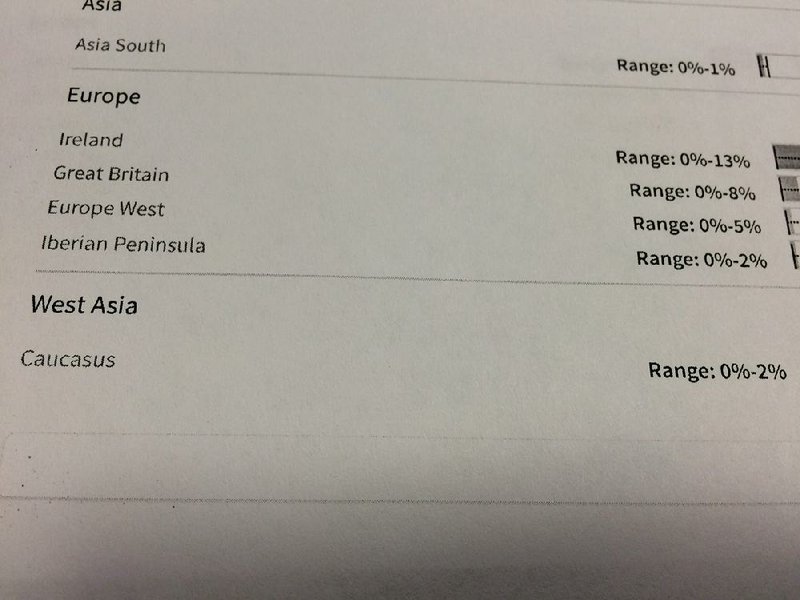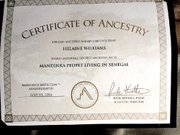Anyone who sees me would not mistake me for being anything other than black. My medium-to-dark skin and (thinning) kinky hair are visual proof.
But I knew that underneath that overall racial designation were other stories to be told about my heritage ... stories that manifested in the form of several longtime family rumors.
One rumor was that rather than having just the usual west African in our ancestry, there was some east African mixed in. My late uncle Tim, my mother's brother and the family historian and scholar, was convinced of our east African roots, citing the relatively thin noses in the family. Meanwhile, my late aunt Ernestine, my mother's sister, spoke of rumors that there was Irish, or possibly Scottish, in us. There was the usual claim of American Indian heritage.
To find out the truth (or untruth) of some of these rumors, I turned to the DNA kit offered by Ancestry.com, which would reveal to me my ethnicity percentage estimates, and AfricanAncestry.com, whose MatriClan test kit would reveal the African ethnic group from which I'm descended through my mother.
The Ancestry.com kit came boxed, with instructions to activate it online via a code on the collection tube, then fill up said tube with saliva via an attached funnel. I was to then replace the funnel with a cap filled with a blue DNA stabilizing solution, shake the tube for at least five seconds, put it into the provided collection bag, put the bag in a prepaid mailing box, and send it off. The African Ancestry kit was a lot simpler: an instruction book and two plastic wrappers, each with three Q- tip-like swabs to use on the inside of my cheek, then place in small white paper envelopes. That, along with a form, was to be returned in a larger prepaid envelope. Both tests promised results in about eight weeks. I sent both samples off in May. On June 26, I got an email from Ancestry.com containing a link to see my results.
First, I was shown a summary, complete with a color-coded pie chart, of my ethnicity estimates (Ancestry.com also provides a history for each country or region included in the results): 31 percent Cameroon/Congo; 26 percent Ivory Coast/Ghana; 13 percent Nigeria; then, "12 more regions."
A page bearing my full ethnicity estimate showed I was approximately 87 percent of African descent; 10 percent European; and the rest, traces of other regions. About 6 percent of my African heritage comes from "Africa Southeastern Bantu"; another 6 percent from Benin/Togo. A color-coded map of Africa showed all these regions, which were pretty much in a row until Congo ... then blossomed out to include just about all of the southern third of the continent, including the east African countries of Kenya and Tanzania. It appeared that Uncle Tim was onto something.
Another rumor that bore out was that of having Irish heritage ... 6 percent. I did have American Indian ancestry, but it showed up only by a single percent.
This test made me all the more curious to see what African ethnic groups I might be descended from. I looked forward to a partial answer from African Ancestry.
The results from that company arrived July 21 in a large manila envelope. My maternal ancestry had been traced back to the Mandinka people of Senegal. Included with my result letter (which itself included a DNA results chart) was a Certificate of Ancestry.
The Mandinkas were highlighted in Alex Haley's Roots, the miniseries whose remake aired earlier this summer. According to online history, the Mandinkas, who were spread out in a handful of countries, were originally from Mali and had founded a west African empire. Today, most Mandinkas live in family compounds or villages led by a chief and council of elders.
I noted with interest that among them, education is traditionally conveyed via oral history and songs. I thought of my late mother, who could have made money with her storytelling skills. And I smiled as I thought of my own occupation as a journalist. Like her, I was carrying on the tradition of my ancestors ... but via the written word.
The DNA tests gave me answers, but they opened up a lot more questions -- questions I know will have to be answered through traditional research -- as well as the help of my father or brother in taking AfricanAncestry.com's PatriClan (paternal) test. I look forward to meeting the challenge.
-- Helaine R. Williams
Style on 08/21/2016

